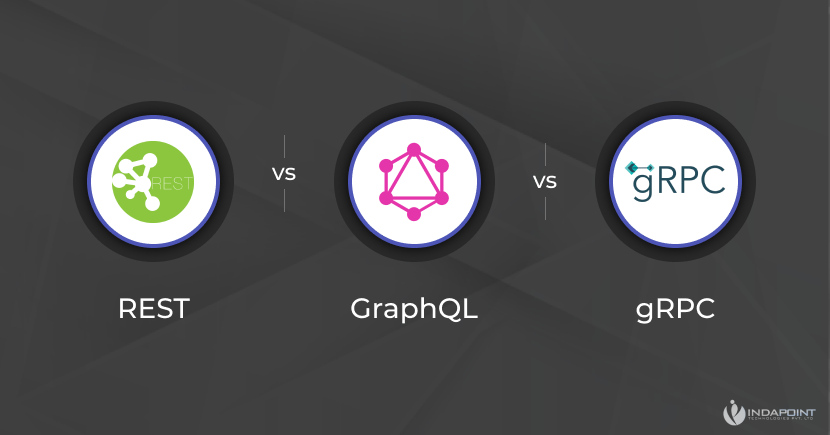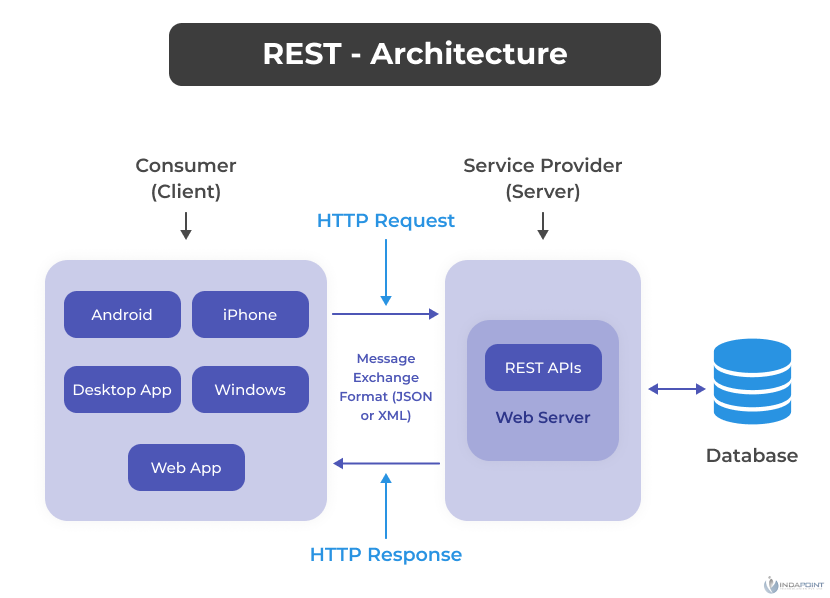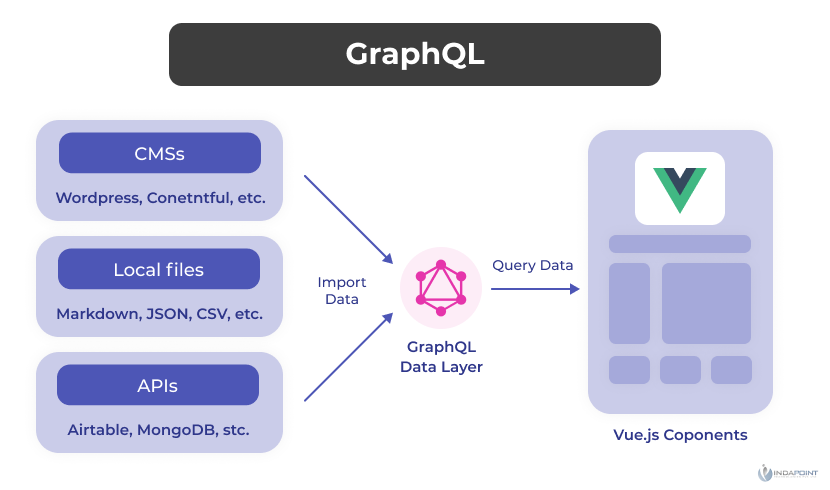REST vs GraphQL vs gRPC
August 25, 2022

Data sharing is incredibly important to all organizations. Workers from multiple organizations and departments will want to exchange information.
Text, documents, videos, and other types of data are all examples of this. Clients will likewise need to go to an organization’s site and solicitation the fundamental data. In this way, there should be a component to make this Data Exchange Process simpler.
Physical Data Storage Devices is a common method of transmitting data in the past, might not be useful in this situation. The good news is that you can access a wide range of Data Exchange Technologies (such as APIs and Web Services) in the modern digital era.
Let us walk you through the detail information about REST, GraphQL & gRPC
REST

REST’s most significant benefit is how advanced the technology industry is. In contrast to GraphQL and gRPC, which could be viewed as niche approaches to building APIs, it is widely used.
Therefore, REST may be your best option if you’re building a commercial API many other developers will use.
The adoption of REST is firstly not difficult. Both its usage and understanding are widespread. Human-readable and simple to examine JSON payloads. REST can provide caching by using URLs as distinct resource IDs as a final performance-enhancing feature.
REST pros
- The most prominent of the three API technologies is REST (representational state transfer). To retrieve, transfer, alter, and delete data, REST uses multiple HTTP verbs like GET, POST, PUT, and DELETE.
- REST API is stateless because the server never retains the client state; instead, it resends requests and any information required for the server to process those requests.
- Caching is implemented using HTTP’s inherent caching headers because REST demands that requests be cacheable wherever possible.
- Caching is simple with REST since it uses HTTP by removing the requirement for constant communication between your client and server, enhancing performance and scalability.
REST cons
- Enormous payloads; unlike GraphQL, which allows you to pick individual fields inside a resource, REST forces you to request the entire resource’s data before looping through it to obtain the data you need, which frequently leads to large payloads.
- Compared to REST, which requires separate requests to be delivered to various endpoints, requiring many round trips, GraphQL allows us to batch diverse resource requests and submit them to the same endpoint at /graphql.
- A database schema can be changed extremely easily with GraphQL. Since queries only entail requesting specific fields, resources can have new fields added without needing you to update your application or trigger breaking changes.
GraphQL

Users can HTTP request data using GraphQL’s structured queries. The needed data’s form and content are specified by the query format using an object-like language. Data-writing requests are also supported. The graph in GraphQL hints at how this is done by leveraging relationships in the server-side data.
When you require robust, effective querying, GraphQL is a suitable fit. Instead of asking from each data source separately, multiple data requirements can be met with a single HTTP request.
It allows the client to control how everything is handled rather than following the standard Server to Client Model. The client selects both the desired data type and the appropriate data format.
GraphQL pros
- You can specify the precise range of data needed in each instance with GraphQL. Your app operates more effectively if extra data isn’t sent from the server to the client.
- GraphQL reduces the need for several round trips to the server to get data for your client by allowing you to choose multiple fields from various resources in a single query.
GraphQL cons
- Since GraphQL has some significant caching issues (particularly with HTTP caching), its adoption has been limited.
- Mentioning too many settled fields on the double can cause round requests that can crash your server because GraphQL questions are developed. REST allows for a more seamless implementation of rate-limiting.
- To create file upload capability, GraphQL also lacks native support for it.
gRPC

The term “Remote Procedure Call” refers to a previous technique with a newer version (RPC). Google created it, and then it became open-source. It functions through agreements and discussions determined by the connection between the Server and the Client rather than the Architecture.
The resource requirements for gRPC are minimal. It is a solid option even in low-powered circumstances because of this. To serialize Structured Data and promote efficient communication, it uses Protocol Buffers (Protobuf). You can utilize gRPC for free because it is Open Source.
Remote Procedure Calls are used by gRPC to communicate data. This indicates that a gRPC API enables client-side code to carry out remote server tasks, like data retrieval. The way that gRPC differs from other RPC implementations is because client code (referred to as a stub) is automatically created in the target language when API operations are first declared in a language-neutral manner.
gRPC pros
gRPC ships with protocol buffers, which accept more data types than JSON and are substantially faster because of their optimized binary format.
Full-duplex streaming is supported by gRPC, making it appropriate for features like video and audio calls. Contrarily, each query is dealt with individually in REST.
To prevent overburdening one server, gRPC implements load balancing, which distributes client requests equally among servers. This enhances your application’s overall performance.
gRPC cons
- There are just a few languages supported by protocol buffers, the official data format for gRPC. Languages like Swift and R are not supported. Nearly all languages are compatible with JSON, which REST uses.
- There are some workarounds available because gRPC doesn’t come with built-in support for browsers.
Battle between REST vs GraphQL vs gRPC
Protocols and Verbs
REST Verbs and Protocols
It makes use of the HTTP 1.1 protocol, in which each element is a resource that can be accessed through a conventional HTTP interface. In a REST-based design, the most frequently utilized HTTP methods tend to be four in number.
gRPC Verbs and Protocols
It employs the multiplexing and bidirectional bidirectional HTTP/2 protocol. The HTTP/1 Protocol has been enhanced by it. In addition, it does not employ JSON but a binary protocol.
GraphQL Protocols and Verbs
The HTTP Protocol is employed. It may be accessible using the playground or a straightforward POST API. Additionally, it supports other names for CRUD operations, like Query and Mutation.
Architecture
REST Architecture
REST lacks a precise API framework or standard, leaving much room for interpretation. Hence, we can guarantee that it has a changed engineering style. The vagueness of not giving pre-characterized reactions to visiting inquiries has provoked the local area to foster systems like JSON: HAL, API, and OData.
gRPC Architecture
Contracts are the underpinning of the gRPC engineering. Rather than the actual Architecture, the Client-Server Relationship characterizes discussion in this engineering. The Client is given the power and commitment to complete an enormous piece of it. The Remote Server with the asset gets a ton of the dealing with and calculation work.
GraphQL Architecture
The Client-Server Relationship is approached distinctively by GraphQL, similar to reversing the conventional model. The Client chooses the information they need and the format they want. The typical Server to Client dictation is reversed in this method, which allows for expanded capabilities.
Final Thoughts
The appropriate API technology for your particular project will ultimately rely on what you want to do. REST may be your best choice if you need a general API that many customers will use.
It might be desirable to let the customers write their own unique queries and acquire only the precise data they need quickly if you require a flexible API that many clients will utilise to perform numerous distinct requests. You can accomplish this with GraphQL.
gRPC is your best option to establish quick, smooth communication between internal services.





